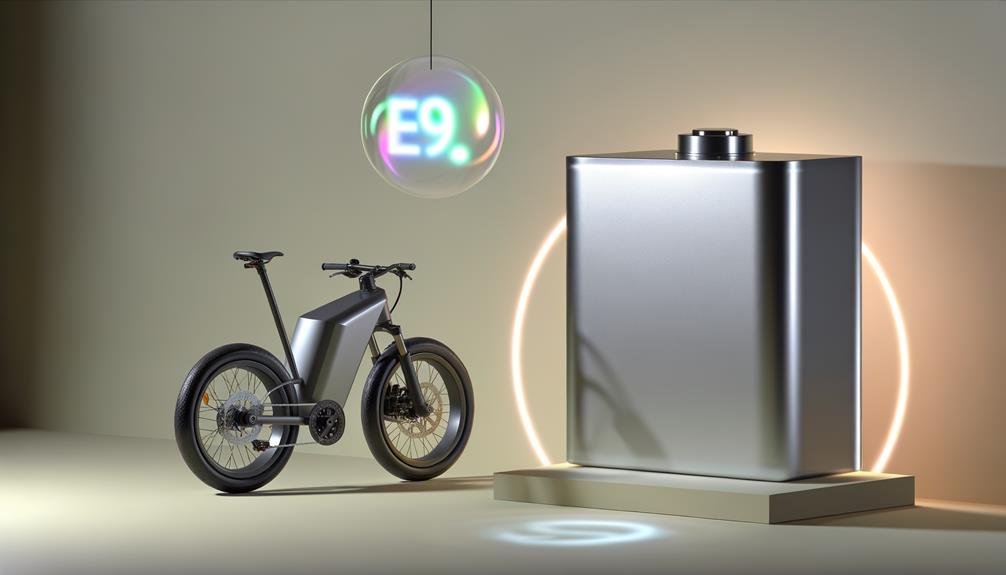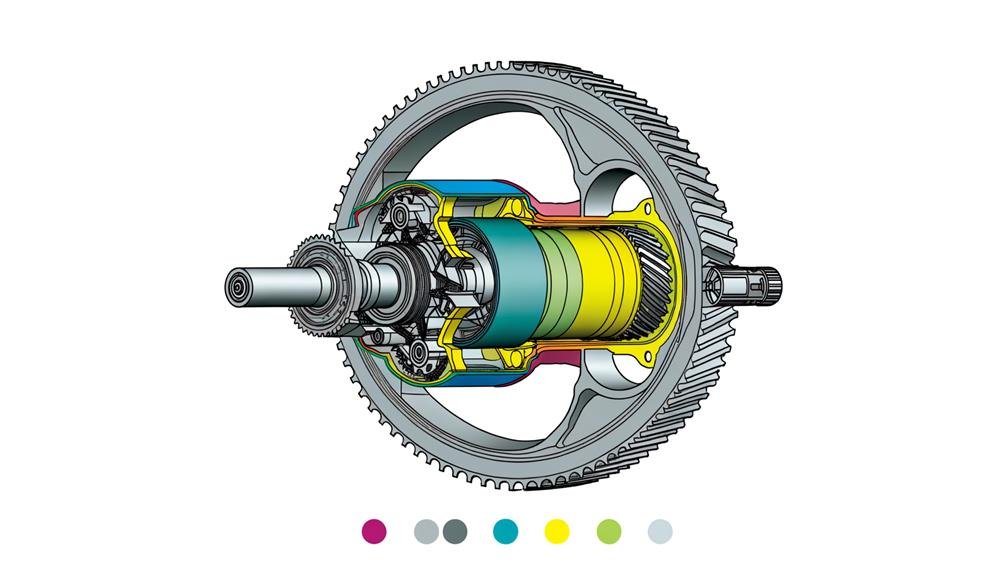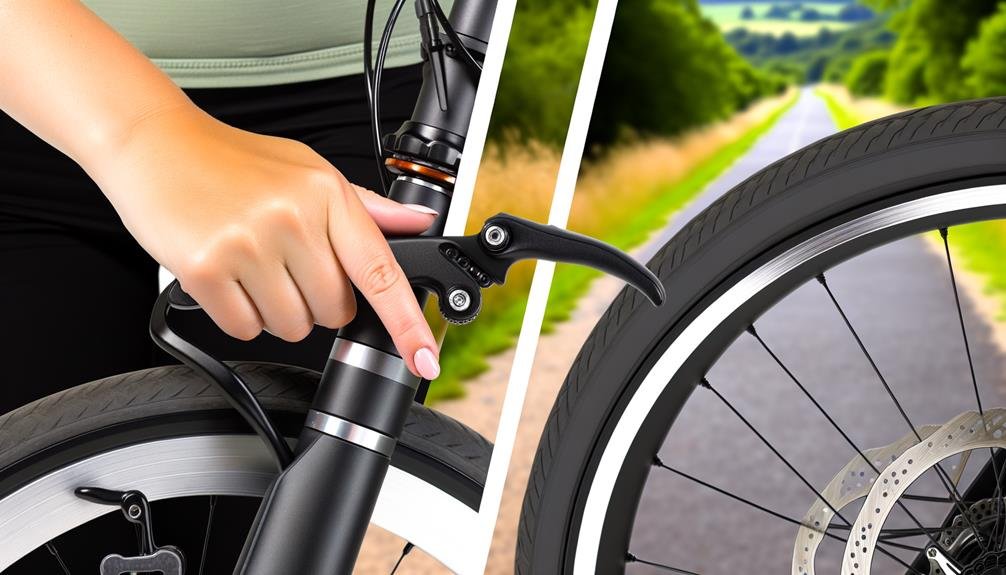Charles Miller is a veteran bike enthusiast with over 12 years of experience dealing with bikes as a mechanic. Despite immense love and expertise for...
Bike batteries, capacities, and conditions – these are the core components that effectively define the distance an electric bike can cover on a single charge, known as its range.
As we explore this topic, we'll tackle various factors that can significantly influence the range of an e-bike, such as the bike's weight, rider's weight, weather conditions, road conditions, and even how the bike is ridden.
By understanding these elements, we can more accurately anticipate an e-bike's performance and maximize its potential.
But how exactly does each factor affect the range, and what can be done to enhance it? Let's continue on this journey to find out.
- Key Takeaways
- Understanding E-Bike Range
- Factors Influencing E-Bike Distance
- Estimating E-Bike Range
- The Role of E-Bike Batteries
- Terrain and E-Bike Range
- Weight Impact on E-Bike Range
- Maximizing Your E-Bike's Range
- Debunking E-Bike Range Myths
- Real-Life E-Bike Range Scenarios
- Frequently Asked Questions
- Conclusion
Key Takeaways
- The range of an electric bike is affected by various factors such as the weight of the rider, riding speed, terrain type, weather conditions, and riding style.
- Battery capacity and type play a significant role in determining the range of an e-bike, with higher weight, resistance, speed, and assistance draining the battery faster and reducing the range.
- The terrain and weight of the rider also influence the range, with uphill paths requiring more power and heavier loads reducing the range. Optimal tire pressure and suitable tires for the terrain can extend the range.
- Estimating the range of an e-bike involves considering the battery type, terrain conditions, and using efficient gear and assistance settings to maximize range. Proper maintenance, regular charging and discharging cycles, and avoiding extreme battery conditions also contribute to the battery's lifespan.
Understanding E-Bike Range
To truly understand the range of an electric bike, it's crucial to consider several influencing factors such as the weight of the rider, riding speed, the terrain, and even the weather conditions. The e-bike range can significantly vary based on these elements. For instance, a heavier rider or a rough terrain can reduce the riding range, while a slower speed can extend it.
E-bike battery quality also plays a pivotal role in determining the maximum range. Bosch Active Line batteries, for instance, can offer a range of up to 180 km, making them ideal for both flat and hilly terrains. On the other hand, Shimano Steps batteries promise an e-bike range of up to 145 km, depending on the model and price.
Most e-bikes can cover between 20-50 miles on a single charge, but this can also be extended. Throttle usage, pedal assistance, tire pressure, and gear selection are all significant factors to consider. By understanding these factors and how they affect an e-bike's range, we can better plan our rides and make the most out of our electric bikes.
Factors Influencing E-Bike Distance
Let's now examine how different factors can influence the distance an e-bike can travel.
Battery capacity is a critical element, with different models offering varying ranges.
Terrain and weight also significantly impact the ride, with uphill paths and heavier loads reducing the distance you can cover on a single charge.
Battery Capacity Impact
Understanding the capacity of an e-bike's battery and how it impacts range requires considering a multitude of factors. This includes the weight of the bike and rider, resistance from weather and road conditions, speed, assistance setting, and shifting efficiency.
To emphasize, let's take a look at this table:
| Factor | Impact on E-Bike Range |
|---|---|
| Weight | Higher weight reduces range |
| Resistance | More resistance, less range |
| Speed | Higher speed drains battery faster |
| Assistance Setting | More assistance, less range |
| Shifting Efficiency | Poor shifting reduces range |
It's clear that battery capacity has a significant impact on your electric bike's range. By managing these factors, we can maximize the range. Remember, understanding the battery capacity impact is crucial for maximizing your E-bike power and range.
Terrain and Weight Influence
While the battery's capacity plays a significant role in determining an e-bike's range, the total weight of the load and the terrain type are equally vital factors to consider.
The range of an electric bike is heavily influenced by terrain and weight. The specific type of terrain dictates the amount of battery assistance needed to propel the bike, with rough or uphill landscapes requiring more power. Similarly, the weight of the load, including the rider and any additional gear, changes how much energy is needed for movement.
High speed riding equals greater energy use and reduces the bike's range. Tire pressure and tire type also play a part; ensuring optimal pressure and choosing tires suitable for your terrain can extend your e-bike's range.
Estimating E-Bike Range
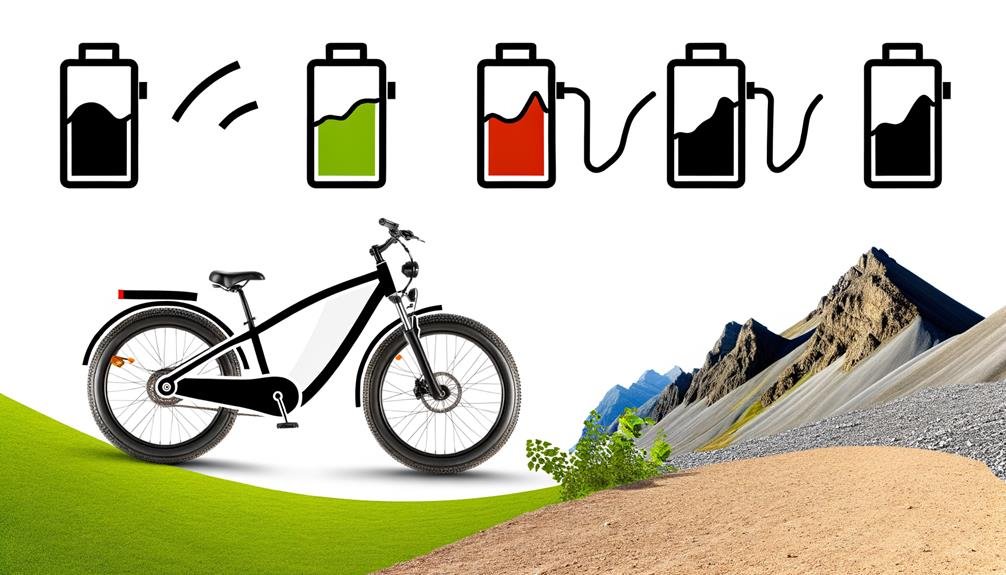
Taking into account factors like weight, resistance, speed, assistance setting, and shifting efficiency, we can estimate the range of an e-bike with greater accuracy. The battery plays a crucial role in determining the range of an electric bike. For instance, the Bosch Active Line battery provides a range of up to 180 km, while the Shimano Steps battery offers up to 145 km.
Your ride's terrain and your own weight as a rider are also critical considerations. For instance, riding on flat or hilly terrain can significantly impact your bike's range. However, a rider can maximize this range by efficiently utilizing the bike's gear and assistance settings.
Consider the table below:
| Battery Type | Range |
|---|---|
| Bosch Active Line | Up to 180 km |
| Shimano Steps | Up to 145 km |
The Role of E-Bike Batteries
In our understanding of e-bike range, it's crucial to consider the role of batteries. Their lifespan and maintenance significantly influence the bike's performance, and certain factors can either enhance or diminish this.
Let's examine these points more closely, starting with battery lifespan and maintenance.
Battery lifespan refers to the amount of time a battery can effectively hold a charge and provide power to the e-bike. This is determined by various factors such as the quality of the battery cells, the charging and discharging cycles, and the overall maintenance of the battery.
Proper maintenance is essential to ensure the longevity of the battery. This includes regular charging and discharging cycles, avoiding overcharging or fully depleting the battery, and keeping the battery at an optimal temperature range. Additionally, it's important to store the battery in a cool and dry place when not in use.
Moving on to factors that affect battery performance, there are several key considerations. Firstly, the terrain and riding conditions can impact the range of an e-bike. Riding uphill or on rough terrain requires more power from the battery, reducing the overall range. On the other hand, riding on flat surfaces or using pedal-assist mode conserves energy and extends the range.
Another factor to consider is the weight of the rider and any additional cargo. Heavier loads require more power from the battery, resulting in a shorter range. Additionally, external environmental factors such as temperature and wind resistance can also affect battery performance.
Battery Lifespan and Maintenance
Understanding the lifespan and maintenance of e-bike batteries is crucial, as they play a significant role in determining the bike's range. To prolong the longevity of your new electric bike, you must learn to manage your ebike correctly to conserve the battery and increase its lifespan.
Factors such as overcharging, extreme temperatures, and excessive discharge can drain your bike's battery, decreasing its efficiency. Regular battery lifespan and maintenance, including timely charges and avoiding full discharges, can ensure an efficient electric bike.
Factors Influencing Battery Performance
Diving into the dynamics of e-bike battery performance, we can't overlook the myriad of factors that influence its efficiency and, consequently, the range of the bike.
The range of your electric bike isn't just about battery capacity— factors influencing battery performance include your weight, the gear you're in, the terrain you're tackling, and your speed.
Battery assistance plays a vital role, especially when you're in pedal assist mode. This mode adjusts the level of assistance based on your pedalling effort, contributing to the bike's range. In simpler terms, the harder you pedal, the less assistance you'll need, thus extending your e-bike's range.
Terrain and E-Bike Range

When it comes to the terrain, it's crucial to know that the range of an e-bike can greatly vary based on elements such as power usage, gear usage, tire quality and pressure, rider effort, bike and load weight, along with weather conditions.
For instance, if you're riding on hilly terrain, the electric bike has to work harder and use more power to climb, which reduces the miles of range. Similarly, rough terrain requires more effort from both rider and bike, reducing the range further. On the other hand, riding on flat streets requires less power, thus increasing the e-bike's range.
To give you a clearer picture:
- Riding on hilly terrain typically reduces the range due to the increased power needed to climb
- Riding on rough terrain can also decrease the e-bike range due to the additional power required to maintain speed
- Flat streets are ideal for maximizing the e-bike's range as they require less power usage
- The 'throttle and go' mode consumes more energy than pedal-assist modes, thus reducing the range
Understanding the interaction between terrain and e-bike range is fundamental to maximizing your riding experience.
Weight Impact on E-Bike Range
Remarkably, the total weight of the load, encompassing both the rider and gear, plays a significant role in determining the range of an electric bike. This weight impact on e-bike range is an essential factor that we can't undervalue. Extra pounds can drain your battery quicker, reducing the lofty range that you may have expected.
For instance, consider two riders on the same 108-volt electric bike, one light and the other heavy. The heavier rider will use as much battery power as possible, leading to a decrease in the e-bike's range. Conversely, the lighter rider will utilize less power, thus extending the range.
Similarly, the weight of any additional gear you carry can also affect the range. It's vital to pack correctly to conserve energy and maintain a respectable range.
An underinflated tire can also decrease your bike's range. It increases rolling resistance, which means the bike needs to work harder, using more energy. Therefore, maintaining optimal tire pressure is crucial for maximizing your e-bike's range.
Maximizing Your E-Bike's Range
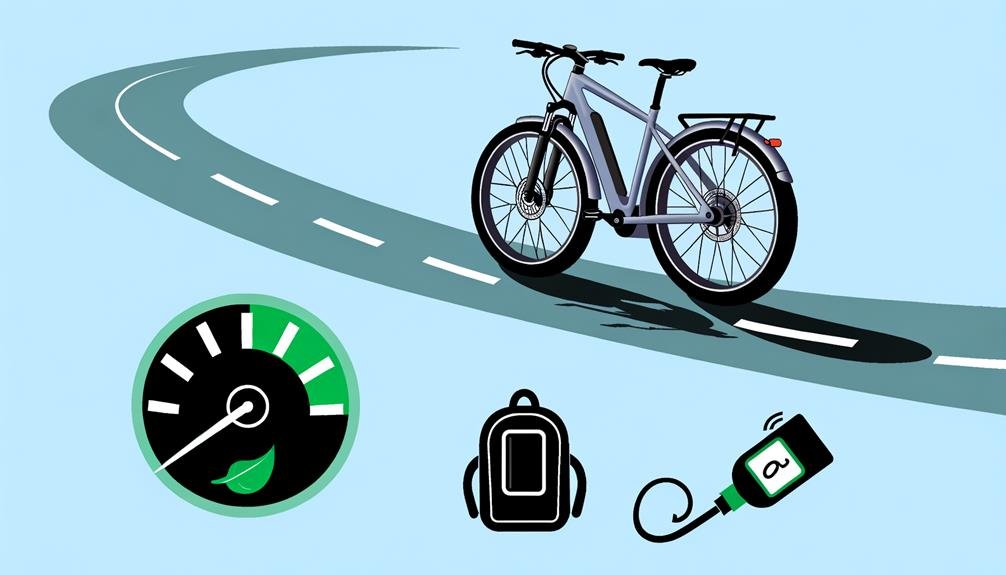
Understanding and leveraging a few key factors can drastically enhance the range of your e-bike, ensuring you get the most out of every charge. Maximizing your e-bike's range is more than just charging it fully; it involves how you ride and maintain your e-bike.
Electric bikes are designed to power the motor with electricity, thus saving your physical energy. However, using low-power assistance while pedaling instead of relying solely on the motor assist will conserve the battery. This technique is especially useful when you're riding on flat streets where you don't need much assistance.
Here are some additional ways to extend the range of an electric bike:
- Maintain proper tire pressure: Filled tires add distance to your ride. A well-inflated tire reduces drag, allowing you to travel further.
- Choose your route wisely: Riding on flat streets requires less power than hilly terrains.
- Use gears efficiently: Shifting to the appropriate gear can reduce the power needed to maintain a certain speed.
- Regular maintenance: A well-maintained e-bike runs more efficiently, increasing the range.
Incorporating these strategies will help you squeeze every possible mile out of your electric bike's battery.
Debunking E-Bike Range Myths
Let's bust some common myths surrounding the range of e-bikes, which often stem from a lack of knowledge about the various factors that can influence it, such as weight, resistance, speed, assistance setting, shifting efficiency, and more. The range of an electric bike refers to the distance it can go on a single charge, but this distance can vary significantly depending on the aforementioned factors.
One myth we've heard is that all e-bikes will have the same range. This is simply untrue. The range of your new e-bike can be influenced by weather conditions, the quality of the battery, and how much power it uses significantly.
Another myth that needs debunking is that carrying extra weight doesn't affect your e-bike's range. The truth is, every extra pound can significantly reduce your range. So, it's best to keep your load light for longer rides.
Real-Life E-Bike Range Scenarios
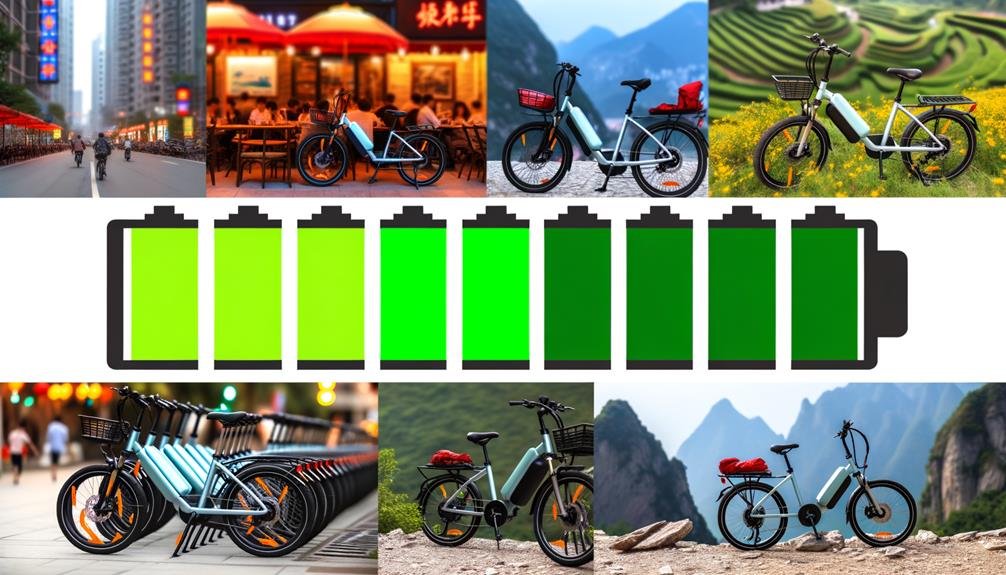
To better understand the range of an e-bike, it's useful to explore some real-life e-bike range scenarios that illustrate how different factors can impact it. Let's delve into a few situations:
- An electric bicycle rider on a flat terrain might get a longer range as less energy is used to combat resistance. However, if they're using unnecessary battery assistance, the range might reduce significantly.
- A shift to a low gear when going uphill can help conserve battery. This approach, achieved by taking advantage of the e-bike's mechanical system, could extend the range.
- If you crank the throttle and maintain high speeds constantly, your e-bike will provide a shorter range. Managing speed efficiently can yield savings in the long run.
- Carrying heavy loads can also impact the range. The heavier the load, the more effort the e-bike needs to move, thus consuming more battery.
Frequently Asked Questions
How Far Can an Electric Bike Go on a Charge?
We've found that an electric bike's range depends on factors like charging efficiency, battery lifespan, terrain impact, rider weight, battery capacity, pedal assistance, speed influence, weather conditions, and maintenance frequency.
How Far Will an E-Bike Go Without Pedaling?
We've found that without pedaling, the battery lifespan, terrain, and speed greatly impact an e-bike's range. Factors like the e-bike's weight, rider weight, weather conditions, and maintenance also significantly affect its efficiency.
How Far Can You Commute on an Electric Bike?
We've found that depending on battery longevity, terrain, and load capacity, you can typically commute 20-50 miles on an electric bike. Weather, riding speed, and availability of charging stations also factor in significantly.
Which Electric Bike Has the Longest Distance?
We've found that the Bosch Active Line e-bike boasts the longest distance, with a range up to 180 km. However, battery longevity, rider weight, terrain, and weather can all affect this impressive distance.
Conclusion
In conclusion, we've seen that an e-bike's range is influenced by numerous factors, including battery type, terrain, weight, and even riding habits.
For instance, a lightweight rider on a flat course with a Bosch Active Line battery could achieve up to 180 km, while others might see significantly less.
Understanding these factors and adjusting accordingly can help you get the most out of your e-bike's range.
It's all about optimizing your ride to your specific circumstances.

Charles Miller is a veteran bike enthusiast with over 12 years of experience dealing with bikes as a mechanic. Despite immense love and expertise for his Tacoma, he rides his Trek Ebike more. Anytime you meet him, you’ll either hear him talking about Bikes, or writing about all things bikes and cars on this blog.
More Posts
